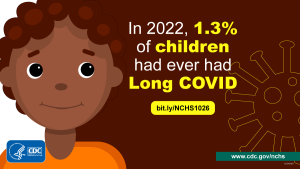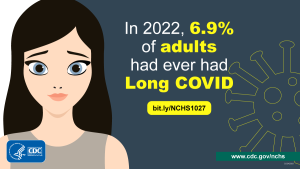New Reports Examine Long COVID in Adults and Children
Posted on by
 NCHS has released two new data brief reports, “Long COVID in Adults: United States, 2022,” and “Long COVID in Children: United States, 2022,” that describe the percentage of individuals who have ever had or currently have Long COVID by sociodemographic and geographic characteristics. Long COVID was defined as self-reporting the presence of symptoms for at least 3 months after having COVID-19 among those who reported either a positive test or a doctor’s diagnosis of COVID-19.
NCHS has released two new data brief reports, “Long COVID in Adults: United States, 2022,” and “Long COVID in Children: United States, 2022,” that describe the percentage of individuals who have ever had or currently have Long COVID by sociodemographic and geographic characteristics. Long COVID was defined as self-reporting the presence of symptoms for at least 3 months after having COVID-19 among those who reported either a positive test or a doctor’s diagnosis of COVID-19.
FINDINGS FROM THE ADULT DATA BRIEF
In 2022, 6.9% of adults ever had Long COVID and 3.4% of adults had Long COVID at the time of the interview (currently have Long COVID).
- The percentage of adults who ever had Long COVID was higher among women (8.5%) compared to men (5.2%). Women (4.4%) were also more likely than men (2.3%) to currently have Long COVID.
- Adults aged 35‒49 (8.9%) were more likely than adults ages 18‒34 (6.9%), 50‒64 (7.6%), and 65 and older (4.1%) to ever have Long COVID.
- Asian non-Hispanic adults (2.6%) were less likely than Black, non-Hispanic (5.4%); White, non-Hispanic (7.1%); and Hispanic (8.3%) adults to ever have Long COVID.
- Adults with family incomes at 400% or more of the federal poverty level were less likely than those with family incomes at 200%‒399% of the federal poverty level to have ever had or currently have Long COVID.
FINDINGS FROM THE CHILD DATA BRIEF
In 2022, 1.3% of children ever had Long COVID, and 0.5% of children had Long COVID at the time of the interview (currently have Long COVID).
- Girls (1.6%) were more likely than boys (0.9%) to have ever had Long COVID.
- Children ages 12‒17 years were more likely than those ages 0‒5 years and those ages 6‒11 years to have ever had or currently have Long COVID.
- Hispanic children (1.9%) were more likely than Asian, non-Hispanic (0.2%) and Black, non-Hispanic children (0.6%) to have ever had Long COVID.
These reports use data from the 2022 National Health Interview Survey. Information about children is based on parent-reported data. NHIS is a nationally representative household survey of the U.S. civilian noninstitutionalized population. It is conducted continuously throughout the year by CDC’s National Center for Health Statistics.

